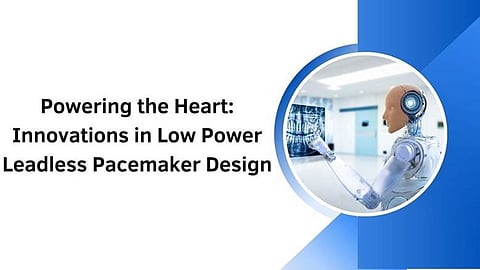

In the evolving landscape of cardiac care, leadless pacemakers represent a breakthrough in medical technology. Rajshaker Reddy Kankula, an expert in biomedical engineering, explores the latest advancements in low-power architectures that enhance the efficiency and longevity of these life-saving devices in his article titled “Design and Development of Low Power Architecture for Leadless Pacemakers: A Technical Analysis”. His research highlights innovative solutions that optimize power consumption, ensuring reliable long-term functionality for patients.
Leadless pacemakers are transforming heart rhythm management by eliminating the complications associated with traditional transvenous lead systems. Conventional pacemakers, while effective, carry risks such as infections, lead dislodgement, and mechanical failures. In contrast, leadless pacemakers integrate the entire pacing system into a compact device implanted directly in the heart, removing the need for leads. This innovation reduces surgical complexity, minimizes post-implantation risks, and enhances patient outcomes.
By offering a less invasive alternative with improved reliability, leadless pacemakers represent a significant advancement in cardiac care, making them an increasingly preferred option for managing arrhythmias and other heart rhythm disorders.
Power constraints are a major challenge in leadless pacemaker design, requiring innovative energy management strategies. With compact batteries offering limited storage, advanced techniques such as dynamic voltage scaling, ultra-low quiescent current regulators, and power gating are being employed to maximize efficiency.
These methods minimize unnecessary power consumption, extending device longevity and reducing the frequency of battery replacement surgeries. By optimizing energy use, modern pacemakers can function reliably for years, enhancing patient safety and comfort. Continuous advancements in low-power electronics are crucial for improving the sustainability of these life-saving devices while maintaining their compact and efficient design.
Wireless telemetry has transformed modern pacemakers by enabling real-time data transmission for remote monitoring and device adjustments. Advanced low-power communication protocols, such as Bluetooth Low Energy (BLE) and Medical Implant Communication Service (MICS), facilitate efficient data exchange while minimizing battery consumption. Additionally, duty-cycled communication strategies ensure that devices transmit data only when necessary, significantly extending battery life.
These innovations empower healthcare providers to continuously monitor patients without frequent in-person visits, enhancing early detection of abnormalities and timely interventions. As a result, remote cardiac care is more effective, reducing hospitalizations and improving patient outcomes. The integration of these technologies marks a significant step toward smarter, more reliable, and patient-friendly cardiac care solutions.
Energy harvesting offers a sustainable alternative to traditional battery-powered pacemakers, reducing the need for frequent replacements. Recent research explores innovative techniques like piezoelectric materials that generate electricity from cardiac motion and thermoelectric generators that harness body heat. These advancements pave the way for self-sustaining pacemakers, enhancing patient convenience and longevity.
By minimizing reliance on batteries, energy harvesting technologies improve medical device efficiency while reducing surgical interventions. As research progresses, integrating these solutions into pacemakers could revolutionize cardiac care, offering a more reliable and sustainable power source for life-saving implants.
Optimizing low-power circuitry is essential for enhancing the efficiency of leadless pacemakers. Advances in ultra-low-power microcontrollers, efficient analog front-end circuits, and optimized memory management techniques are driving significant energy savings. Low-power design strategies ensure minimal energy consumption while maintaining reliable functionality. Additionally, innovative pacing algorithms dynamically adjust stimulation parameters based on real-time cardiac activity, further optimizing power usage.
These advancements extend device longevity, reduce battery depletion rates, and enhance patient outcomes. By integrating energy-efficient components and intelligent power management techniques, modern leadless pacemakers achieve superior performance with minimal power consumption, ensuring sustained and effective cardiac support.
The long-term success of leadless pacemakers depends on their biocompatibility and durability. Advanced materials such as titanium alloys and polymeric coatings improve tissue integration while minimizing inflammatory responses. Additionally, rigorous reliability testing, including accelerated aging studies and environmental stress assessments, ensures that these devices maintain optimal performance over extended periods.
Artificial intelligence is becoming an extremely practical source for leadless pacemaker adaptation. AI driven signals can be accumulations allowing arrhythmia detection and adaptive strategies for pacing to be more individual. Machine learning algorithms could create vast amounts of data on the heart generate predictions of possible complications and allow pace aspirations during paces themselves. The next levels will involve the bunch of intelligent cardiac care solutions with AI driven remote monitoring of one's entire health status.
Leadless pacemakers have revolutionized the patient care experience in escalation management of cardiac rhythms. Budgets for progress through which advanced low-power electronics, global wireless communication, energy harvesting, and AI-based diagnostics impact the performance of devices increase their utility and practicality in direct patient care. This will indeed narrow the gap between future research and intelligence efforts to miniaturize pacemakers further, provide ultra-power autonomy, and personalize even better therapies for the heart. Rajshaker Reddy Kankula's work will add this flavor to that enhancement and bring us closer to transforming cardiac care into a new level of innovation and sustainability.
